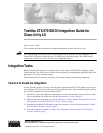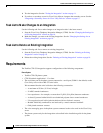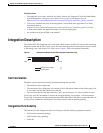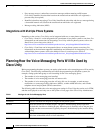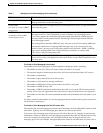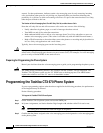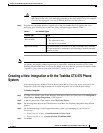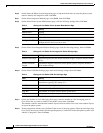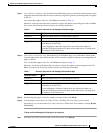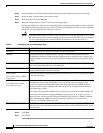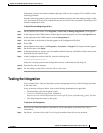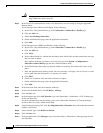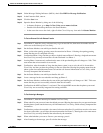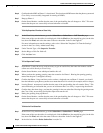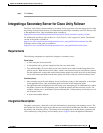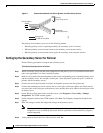
4
Toshiba CTX 670 SMDI Integration Guide for Cisco Unity 4.0
OL-4404-07
Toshiba CTX 670 SMDI Integration Guide for Cisco Unity 4.0
Planning How the Voice Messaging Ports Will Be Used by Cisco Unity
• Easy message access (a subscriber can retrieve messages without entering an ID because
Cisco Unity identifies the subscriber based on the extension from which the call originated; a
password may be required)
• Identified subscriber messaging (Cisco Unity identifies the subscriber who leaves a message during
a forwarded internal call, based on the extension from which the call originated)
• Message waiting indication (MWI)
Integrations with Multiple Phone Systems
Depending on the version, Cisco Unity can be integrated with two or more phone systems:
• Cisco Unity 4.0 and 4.1 can be integrated with a maximum of two phone systems at one time. For
information on and instructions for integrating Cisco Unity with two phone systems, refer to the
Dual Phone System Integration Guide at
http://www.cisco.com/univercd/cc/td/doc/product/voice/c_unity/integuid/multi/itmultin.htm.
• Cisco Unity 4.2 and later can be integrated with two or more phone systems at one time. For
information on the maximum supported combinations and instructions for integrating Cisco Unity
with multiple phone systems, refer to the Multiple Phone System Integration Guide at
http://www.cisco.com/univercd/cc/td/doc/product/voice/c_unity/integuid/multi/multcu42.htm.
Planning How the Voice Messaging Ports Will Be Used by
Cisco Unity
Before programming the phone system, you need to plan how the voice messaging ports will be used by
Cisco Unity. The following considerations will affect the programming for the phone system (for
example, setting up the hunt group or call forwarding for the voice messaging ports):
• The number of voice messaging ports installed.
• The number of voice messaging ports that will answer calls.
• The number of voice messaging ports that will only dial out, for example, to send message
notification, to set message waiting indicators (MWIs), to make AMIS deliveries, and to make
telephone record and playback (TRAP) connections.
The following table describes the voice messaging port settings in Cisco Unity that can be set in UTIM,
and that are displayed as read-only text on the System > Ports page of the Cisco Unity Administrator.
Table 1 Settings for the Voice Messaging Ports
Field Considerations
Extension Enter the extension for the port as assigned on the phone system.
Enabled Check this check box to enable the port. The port is enabled during normal operation.
Uncheck this check box to disable the port. When the port is disabled, calls to the port get a
ringing tone but are not answered. Typically, the port is disabled only by the installer during
testing.
Answer Calls Check this check box to designate the port for answering calls. These calls can be incoming
calls from unidentified callers or from subscribers.



